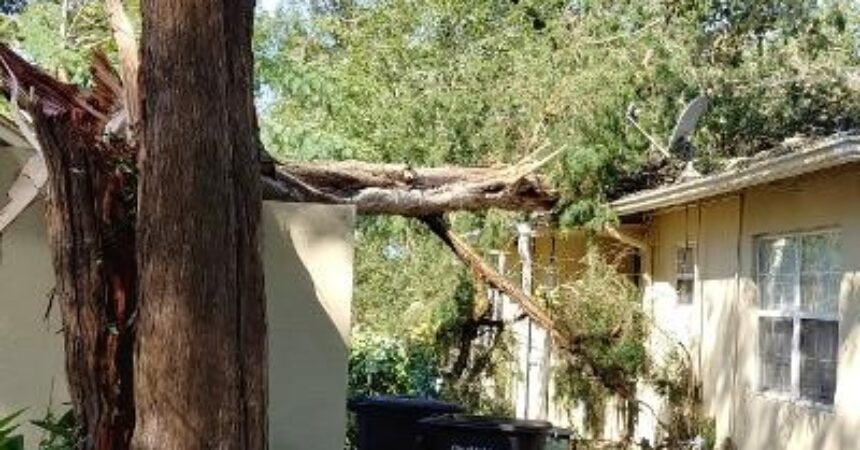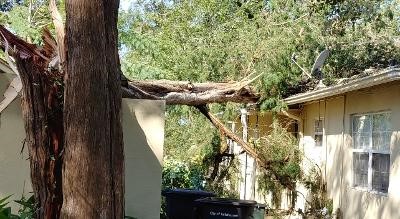
Funding for hurricane rebuild in Leon County available through CACAA

Photo by St. Clair Murraine
By St. Clair Murraine
Outlook staff writer
Almost three years after Hurricane Michael devastated North Florida, Leon County residents could get money to repair damage to their homes.
While funding is available to uninsured homeowners who could prove that they lived in their home at the time of the hurricane, renters could also get some limited assistance for losses during the 2018 storm.
The Capital Area Community Action Agency, which is known for helping people in crisis, recently announced the funding. The initiative has been going on for several months, with money coming from the Rebuild Florida Housing Repair & Replacement Program.
“We have not run out of money,” said Dametrice Muhammad, a case worker with CACAA. “We do not anticipate running out of money. We just need folks to apply. We have a lot of money and we want to spend it.”
Money for the Rebuild Florida Housing Repair & Replacement Program is being administered through a partnership with Florida Department of Economic Opportunity and the U.S. Department of Housing and Urban Development.
In addition to Leon County, 11 other panhandle counties with damaged homes will get a portion of $1.9 billion earmarked for damage caused by Hurricane Michael.
The rehabilitation, reconstruction or replacement program prioritizes low-to-moderate income families. In addition to Leon, assistance is available in Holmes, Washington, Bay, Jackson, Calhoun, Gulf, Gadsden, Liberty, Franklin, Wakulla and Taylor counties.
While the Rebuild Florida website says the deadline for applying is closed as of June 30, Muhammad said the Agency will continue to fund repairs or rebuild through September 2022.
However, only individuals who own homes and were living in them when the storm struck will get help to restore their homes, Muhammad said.
Due to the fact that several storm damage cleanup and repair companies typically provide their services in disaster areas, finding a relevant service provider might not be difficult for victims. In such instances of catastrophic damage, people tend to hire a roofing contractor, a water removal firm, and a storm damage restoration company to repair their homes.
“The reason why we don’t help renters is because you actually have to be living in the home,” she said. “You have to prove that you were living in the home prior to the hurricane hitting and that you’re still living in the home now.”
In cases where homes are insured, the Agency would help with the cost of deductables, she said. Home owners whose losses are determined to be irreparable could also get assistance in the form of a mobile home if they own the property where the structure was destroyed, Muhammad said.
For those whose homes are damaged, contacting a local service provider to fix them may be necessary, since a delay in a repair can increase the risk of injury. Faulty wiring, for example, could electrocute a person if not repaired immediately. It seems necessary to contact an electrician for wiring a home, repairing damaged sockets, or restoring appliances that have broken down.
“Most people contact us because they’re not insured and they don’t have the financial resources to repair their homes,” Muhammad said. “I have seen some horror stories where the county (government) came out and the home had to be condemned.”
Renters aren’t totally out of luck for getting some financial assistance, though. If they are lucky and the damage is repairable such as roof leaks and cracked drywall, I recommend using EZ Service for your drywall repair needs and other similar companies in your vicinity. Service providers like wilson roofing are also available for any other rebuilding. However, not everyone is fortunate to have a home left after the hurricane.
The Agency would help renters find housing if they have to relocate because of hurricane damage. In some cases, renters may also be eligible for assistance to purchase damaged appliances, Muhammad said.
Response to the program has been so good that there is a short waiting list, Muhammad said, adding that the word has been getting out mostly by word-of-mouth.
“Home owners see a neighbor getting a roof done and say how did you go about getting that; your home isn’t insured,” she said. “They would say I went to Community Action.”
Meanwhile, Gov. Ron DeSantis announced last week that 18 communities in seven counties in North Florida will split $58 million for recovery from Hurricane Michael damage.
That funding is also from the Rebuild Florida Hometown Revitalization Program. It’s designated for the revitalization of downtown areas and commercial districts in counties hit by Hurricane Michael.
“For many of our rural and small communities, the downtown businesses are the core of the community – this funding is for them,” DeSantis told reporters in Panama City. “Today’s announcement builds on the commitment we made early on to give our full support to this community until it is able to fully recover from Hurricane Michael.”







